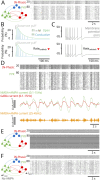This is a preprint.
Ketamine can produce oscillatory dynamics by engaging mechanisms dependent on the kinetics of NMDA receptors
- PMID: 38617266
- PMCID: PMC11014619
- DOI: 10.1101/2024.04.03.587998
Ketamine can produce oscillatory dynamics by engaging mechanisms dependent on the kinetics of NMDA receptors
Update in
-
Ketamine can produce oscillatory dynamics by engaging mechanisms dependent on the kinetics of NMDA receptors.Proc Natl Acad Sci U S A. 2024 May 28;121(22):e2402732121. doi: 10.1073/pnas.2402732121. Epub 2024 May 20. Proc Natl Acad Sci U S A. 2024. PMID: 38768339 Free PMC article.
Abstract
Ketamine is an NMDA-receptor antagonist that produces sedation, analgesia and dissociation at low doses and profound unconsciousness with antinociception at high doses. At high and low doses, ketamine can generate gamma oscillations (>25 Hz) in the electroencephalogram (EEG). The gamma oscillations are interrupted by slow-delta oscillations (0.1-4 Hz) at high doses. Ketamine's primary molecular targets and its oscillatory dynamics have been characterized. However, how the actions of ketamine at the subcellular level give rise to the oscillatory dynamics observed at the network level remains unknown. By developing a biophysical model of cortical circuits, we demonstrate how NMDA-receptor antagonism by ketamine can produce the oscillatory dynamics observed in human EEG recordings and non-human primate local field potential recordings. We have discovered how impaired NMDA-receptor kinetics can cause disinhibition in neuronal circuits and how a disinhibited interaction between NMDA-receptor-mediated excitation and GABA-receptor-mediated inhibition can produce gamma oscillations at high and low doses, and slow-delta oscillations at high doses. Our work uncovers general mechanisms for generating oscillatory brain dynamics that differs from ones previously reported, and provides important insights into ketamine's mechanisms of action as an anesthetic and as a therapy for treatment-resistant depression.
Keywords: Antidepressant effect; Biophysical mechanisms; Gamma oscillations; NMDA-receptor antagonism; Slow-delta oscillations.
Conflict of interest statement
Conflict of interest The authors declare no conflict of interest.
Figures






References
-
- Moghaddam B. Ketamine. MIT Press; 2021.
Publication types
Grants and funding
LinkOut - more resources
Full Text Sources
